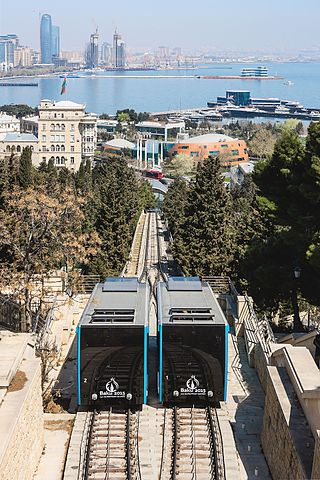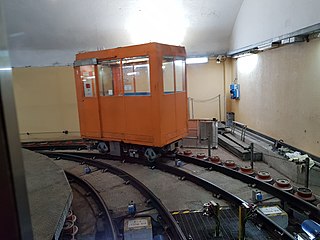
A funicular is a type of cable railway system that connects points along a railway track laid on a steep slope. The system is characterized by two counterbalanced carriages permanently attached to opposite ends of a haulage cable, which is looped over a pulley at the upper end of the track. The result of such a configuration is that the two carriages move synchronously: as one ascends, the other descends at an equal speed. This feature distinguishes funiculars from inclined elevators, which have a single car that is hauled uphill.

The Genoa Metro is a rapid transit consisting of a single line that connects the centre of Genoa, Italy with the suburb of Rivarolo Ligure, to the north-west of the city centre. The service is currently managed by Azienda Mobilità e Trasporti (AMT), which provides public transport for the city of Genoa.

The Trieste–Opicina tramway is an unusual hybrid tramway and funicular railway in the city of Trieste, Italy. It links Piazza Oberdan, on the northern edge of the city centre, with the village of Villa Opicina in the hills above.

The Central Funicular, is one of four funiculars in the public transportion system of Naples, Italy. The system is a true funicular: an inclined railway with two passenger cars, connected via cables, operating in concert.

Genova Piazza Principe railway station is the central station of Genoa and is located on Piazza Acquaverde, occupying the entire north side of Via Andrea Doria—where the station entrance is located—in the town centre and a short distance from the Palazzo del Principe, from which it takes its name. It is used by about 66,000 passengers per day and 24,000,000 per year. The first temporary station was opened in 1854 at the end of the line from Turin. Lines were later opened to Milan, Rome and the French border at Ventimiglia.

The Chiaia Funicular is one of four funiculars in the public transportion system of Naples, Italy. Each system is a true funicular: an inclined railway with two passenger cars connected via cables, operating in concert.

The Mergellina Funicular, is one of four operating funiculars in the public transportion system of Naples, Italy. The system is a true funicular: an inclined railway with two passenger cars, connected via cables, operating in concert.

The Montesanto Funicular, is one of four operating funiculars in the public transportion system of Naples, Italy. The system is a true funicular: an inclined railway with two passenger cars connected via cables, operating in concert.

Genova Sampierdarena railway station is located in Piazza Montano, in the Sampierdarena district of Genoa, Italy. It is Genoa's third most important railway station, after Genova Piazza Principe and Genova Brignole.

An inclined elevator or inclined lift is a form of cable railway that hauls rail cars up a steep gradient.

The Zecca–Righi funicular is a funicular railway in the Italian city of Genoa connecting the Largo della Zecca, on the edge of the historic city centre, to several stations on the slope of the Righi hill. The line is one of several true funiculars in the city, including the Sant'Anna funicular and the Quezzi funicular, although the Principe–Granarolo rack railway is also sometimes erroneously described as a funicular.

The AMT Genova, formally known as the Azienda Mobilità e Trasporti and formerly as the Azienda Municipalizzata Trasporti, is a joint stock company that holds the concession for public transport in the Italian city of Genoa.

The Sant'Anna funicular is a funicular railway in the Italian city of Genoa connecting the Piazza Portello, on the edge of the historic city centre, to the Corso Magenta. The line is one of several true funiculars in the city, including the Zecca–Righi funicular and the Quezzi funicular, although the Principe–Granarolo rack railway is also sometimes erroneously described as a funicular.

The Odesa Funicular serves the Ukrainian city of Odesa. Running alongside the Potemkin Stairs, it connects the Primorsky Boulevard with the Port of Odesa.

Ascensore Castello d'Albertis-Montegalletto is a combined funicular and lift in Genoa, Italy. It connects via Balbi, near Genova Piazza Principe railway station, to corso Dogali near Albertis Castle, home of the Museo delle Culture del Mondo. It is run by AMT Genova.

The Magenta–Crocco elevator is a public elevator in the Castelletto quarter of Genoa, in Northwestern Italy. It constitutes the continuation of the Sant'Anna funicular, linking Corso Magenta with via Antonio Crocco.

The Lugano degli Angioli funicular was a funicular railway and inclined lift in the city of Lugano in the Swiss canton of Ticino. It linked a lower terminus near the lakeside and the church of Santa Maria degli Angioli with an upper terminus adjacent to the Hotel Bristol. The upper station was on the third floor of a tower, linked with a footbridge to the hotel. The line had a single track and single car, which was balanced by a vertically operating counterweight in the tower.

The Principe–Granarolo rack railway is a rack railway in the Italian city of Genoa that connects via del Lagaccio, near the Genoa Piazza Principe railway station, to the Granarolo hills. The line is sometimes erroneously described as a funicular and listed alongside the city's Zecca–Righi funicular, the Sant'Anna funicular and the Quezzi funicular. The line is managed by AMT Genova, which manages the city's public transport.

The Sorrento Funicular was a steam-driven, inclined rail system located in the commune of Sorrento, within the Municipality of Naples, Italy — connecting its upper terminus at Sorrento's Hotel Vittoria to the resort's port, several hundred feet below on the Gulf of Naples. The system was designed by Italian engineer Alessandro Ferretti, began operating in 1883 and stopped operating approximately three years later.



















